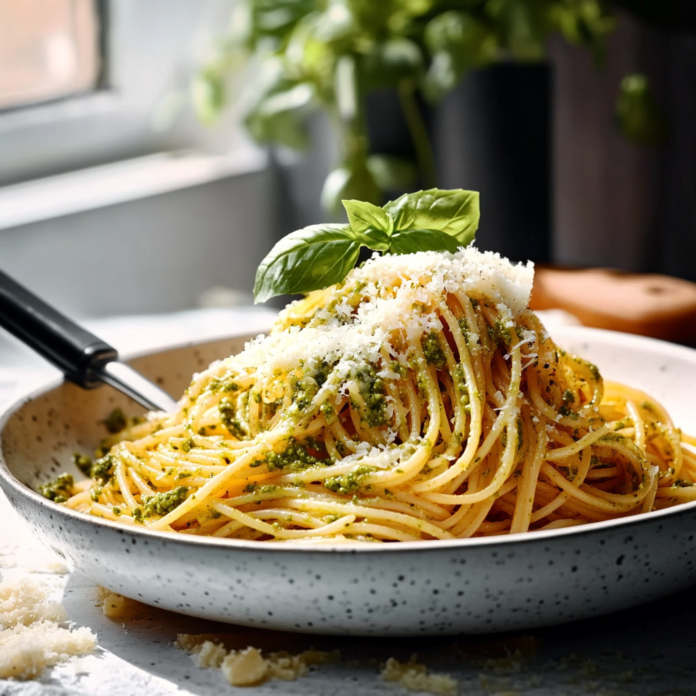Introduction and Quick Summary
Spaghetti with Pesto and Parmesan is a delightful dish that brings together the rich flavors of fresh basil, garlic, pine nuts, olive oil, and aged cheese. This classic Italian recipe is not only simple to prepare but also incredibly satisfying. Perfect for a quick weeknight dinner or an elegant gathering, this dish allows the vibrant green pesto to shine against the al dente spaghetti.
Making homemade pesto elevates this dish from ordinary to extraordinary. It captures the essence of summer in every bite. With just a few ingredients readily available in your kitchen or at local markets, you can whip up this meal in no time. Whether you’re feeding a family or hosting friends, Spaghetti with Pesto and Parmesan is guaranteed to impress.
In this article, we will guide you through the core ingredients you’ll need to create this luscious dish from scratch. Additionally, we will provide detailed step-by-step instructions on how to prepare it flawlessly. Finally, we’ll share some serving suggestions and storage tips so that you can savor leftovers in style.
Main Ingredients
Fresh Basil Leaves
Fresh basil forms the heart of your pesto sauce. You’ll need about 2 cups of tightly packed basil leaves for this recipe. Not only does basil have a fragrant aroma that enhances the dish’s flavor profile but it also contains antioxidants that are beneficial for your health. Choose vibrant green leaves without any brown spots for the best results.
Pine Nuts
For that nutty richness in your pesto, you’ll require 1/4 cup of pine nuts. Toasting them lightly before mixing them into the pesto will deepen their flavor significantly. Pine nuts add creaminess to the sauce while providing healthy fats essential for a balanced diet.
Garlic Cloves
Garlic adds a sharp kick to your pesto sauce. You’ll need 2-3 cloves of fresh garlic for this recipe. Depending on how garlicky you want your pasta to taste, feel free to adjust the amount used. Garlic has numerous health benefits including anti-inflammatory properties which can boost your immune system.
Olive Oil
Olive oil serves as the base for your pesto and helps blend all ingredients smoothly together. Use about 1/2 cup of extra virgin olive oil for optimal flavor. This high-quality oil not only enhances taste but also provides healthy monounsaturated fats that are good for heart health.
Grated Parmesan Cheese
Grated Parmesan is essential for adding a savory depth to your dish. You’ll need approximately 1/2 cup of freshly grated Parmesan cheese in this recipe. The cheese should be added both into the pesto mixture as well as sprinkled on top when serving for an extra touch of flavor.
Spaghetti Pasta
The star ingredient in this dish is obviously spaghetti itself! You will need about 12 ounces (340 grams) of dried spaghetti noodles. Opting for high-quality pasta ensures better texture and taste after cooking.
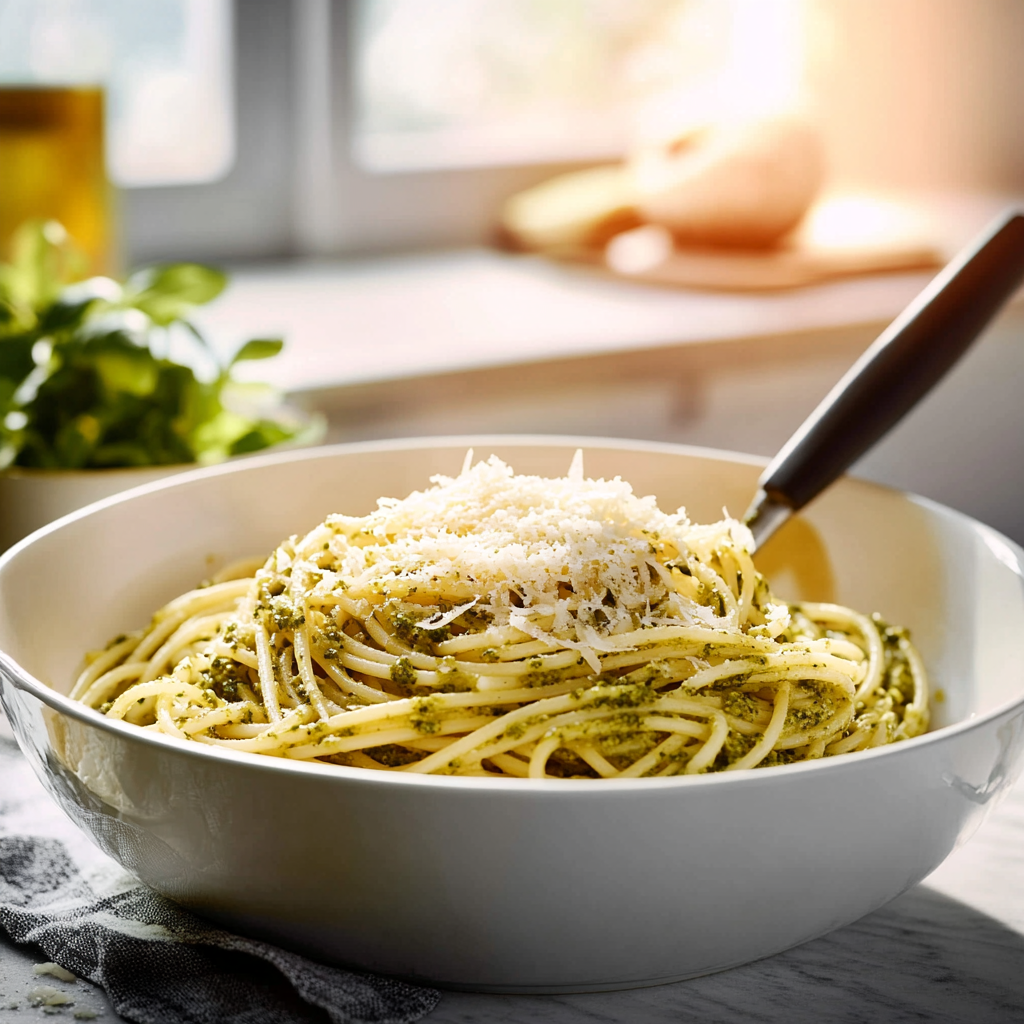
How to Prepare Spaghetti with Pesto and Parmesan
Step 1: Cook the Spaghetti
Begin by bringing a large pot of salted water to a boil over high heat. Once boiling vigorously, add your 12 ounces of spaghetti pasta into the pot carefully to avoid splashes. Stir occasionally to prevent sticking until the pasta is cooked al dente according to package instructions—usually around 8-10 minutes depending on thickness.
Once cooked perfectly, reserve about 1 cup of pasta water before draining in a colander; this starchy water will help emulsify your sauce later if needed! Rinse briefly under cold water if you wish to stop cooking further; however, traditionalists often skip this step as it can wash away starches crucial for flavor adherence.
Step 2: Make the Pesto Sauce
While your pasta cooks away happily in its bubbling bath, it’s time to prepare that amazing pesto! Start by placing 2 cups of fresh basil leaves into a food processor along with 1/4 cup toasted pine nuts and 2-3 peeled garlic cloves.
Pulse these ingredients until finely chopped before slowly drizzling in 1/2 cup extra virgin olive oil through the feed tube while processing continuously until smooth consistency forms—about one minute should do it! Lastly add in roughly 1/2 cup grated Parmesan cheese along with salt & pepper per taste preference while pulsing again until fully incorporated.
Step 3: Combine Pasta & Sauce
Now comes the fun part—combining everything together! In a large mixing bowl or directly back into your pot (off heat), add cooked drained spaghetti followed by generous dollops (or all) of your freshly made pesto sauce atop it—a wonderful sight indeed!
Toss gently yet thoroughly using tongs until every strand is evenly coated; if you notice dryness at all don’t forget about that reserved pasta water! Add small splashes gradually while continuing tossing until desired creaminess achieved—this starchy addition really elevates each bite!
Step 4: Serve & Garnish
To serve up your delicious creation beautifully plate portions onto individual bowls or plates then sprinkle additional grated Parmesan cheese over each serving generously—it’s hard not too when it looks so good! For those who enjoy extra brightness consider adding fresh cherry tomatoes sliced open alongside some crushed red pepper flakes if desired; these toppings not only enhance aesthetics but pack even more flavors too!
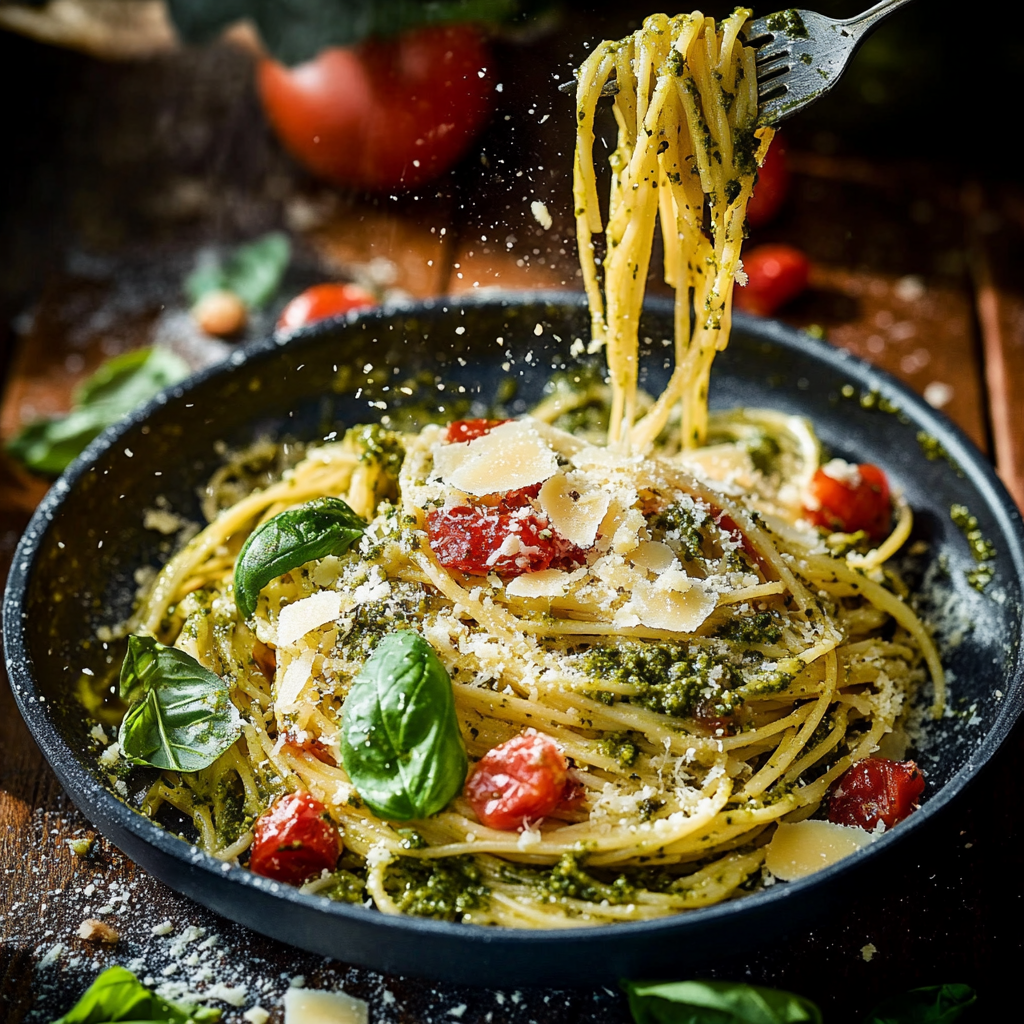
Serving and Storing Tips
Serving Suggestions
When serving Spaghetti with Pesto and Parmesan, presentation matters just as much as taste! Consider using wide-rimmed bowls where twirls of spaghetti can take center stage—this creates an appealing visual experience right from first glance! Pair this dish with freshly baked bread like focaccia or crusty baguettes alongside light salads featuring seasonal vegetables dressed simply in lemon vinaigrette which complements flavors nicely without overwhelming palate overall.
For drinks pairing options try white wines such as Pinot Grigio or Vermentino which offer refreshing notes that balance richness found within creamy sauces beautifully; alternatively sparkling waters adorned with lemon slices provide great non-alcoholic refreshment too!
Storing Leftovers
If you happen upon any leftovers don’t fret—they store beautifully! Allow any uneaten portions cool completely before transferring them into airtight containers; they’ll keep well refrigerated up-to three days without compromising quality too much! To reheat simply place desired servings back onto stovetop over low heat stirring regularly allowing flavors meld again—and feel free adding splash more olive oil/water if necessary!
Alternatively freeze portions wrapped tightly with plastic wrap followed by foil covering securely ensuring freshness preserved longer thus enabling easy meals down road; thaw overnight prior usage then reheat method mentioned above keeping everything tasty still!
By following these steps closely while utilizing our tips above enjoying delightful Spaghetti with Pesto and Parmesan becomes effortless endeavor worthy sharing amongst family/guests alike—buon appetito!
Mistakes to avoid
One common mistake when preparing spaghetti with pesto and Parmesan is overcooking the pasta. It’s essential to follow the package instructions for al dente cooking, which ensures that the pasta retains a slight bite. Overcooked spaghetti becomes mushy and loses its appealing texture. Always taste your pasta a minute or two before the recommended cooking time to achieve the perfect consistency.
Another frequent error is neglecting to reserve pasta water. This starchy liquid can be a game changer when mixing your spaghetti with pesto. Adding a splash of reserved water can help the pesto adhere better and create a creamier sauce without using additional oil or cream. Always set aside at least a cup of water before draining your pasta.
Using store-bought pesto without any enhancements can also diminish the flavor of your dish. While convenience is key, freshening up jarred pesto with ingredients like lemon juice, garlic, or extra Parmesan can elevate your meal significantly. Homemade pesto offers an even better option, allowing you to control flavors and textures.
Lastly, skimping on the Parmesan cheese can lead to blandness in your dish. Quality Parmesan adds depth and richness that complements both the spaghetti and pesto beautifully. Always use freshly grated Parmesan instead of pre-grated varieties for optimal flavor.
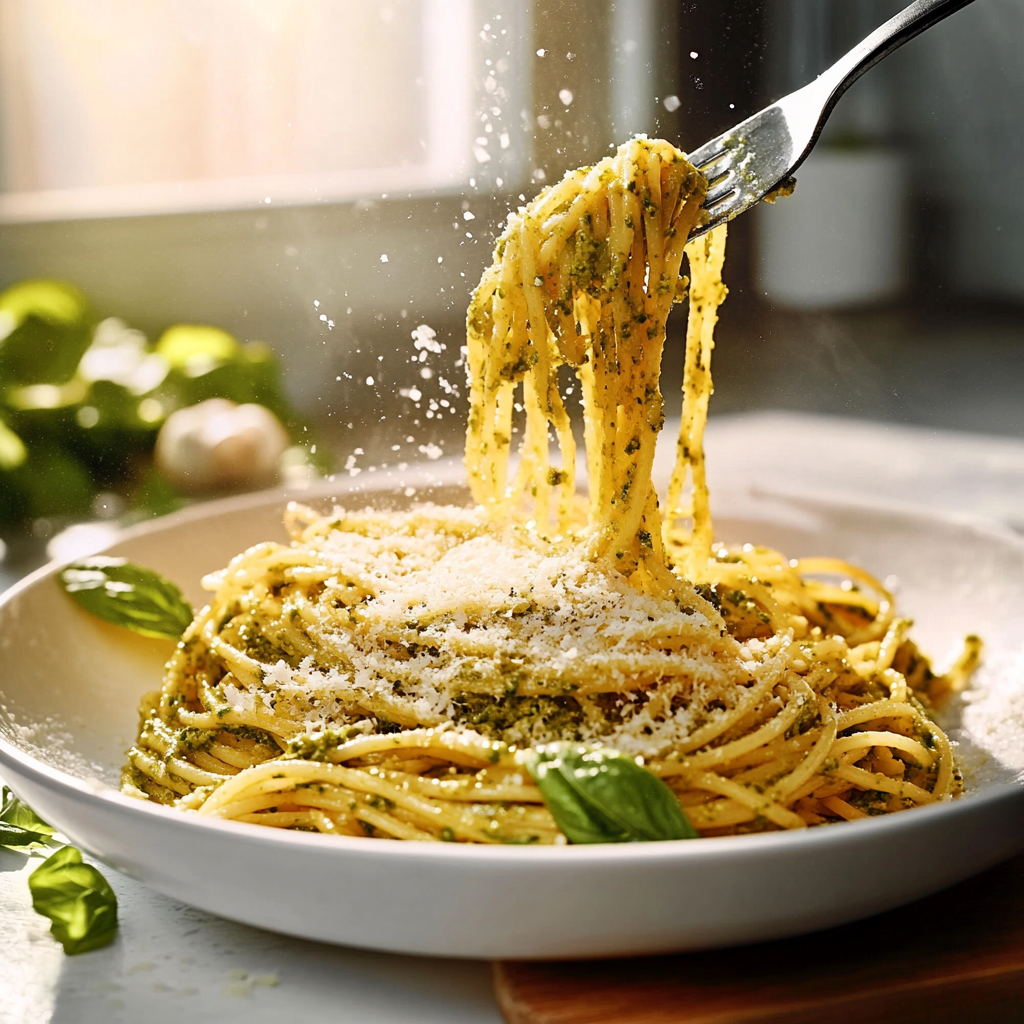
Tips and tricks
To elevate your spaghetti with pesto and Parmesan, consider using high-quality ingredients. Fresh basil is essential for a vibrant pesto, as it delivers a fragrant aroma and authentic taste. Look for bright green leaves that are firm and free from blemishes. If possible, source your basil from local markets or even grow it at home.
When making your own pesto, experiment with different nuts such as pine nuts, walnuts, or almonds. Each nut brings its unique flavor profile to the sauce while maintaining that creamy texture you desire. Toasting the nuts lightly before blending can also enhance their flavor and create a richer sauce.
Timing is crucial when combining your spaghetti with pesto and Parmesan. After draining the pasta, quickly toss it with the pesto while it’s still hot; this helps meld the flavors together effectively. Incorporate freshly grated Parmesan immediately after adding the pesto for better melting and distribution throughout each strand of spaghetti.
Garnishing plays an important role in presentation as well as flavor enhancement. A sprinkle of toasted pine nuts or walnuts on top adds not only crunch but also visual appeal to your dish. Additionally, fresh basil leaves can serve as an eye-catching garnish that hints at the delicious flavors within.
Suggestions for Spaghetti with Pesto and Parmesan
If you want to make your spaghetti with pesto and Parmesan more nutritious, consider adding vegetables such as cherry tomatoes or spinach right into the mix. These ingredients provide vibrant color along with added vitamins and minerals, making your dish more balanced while enhancing its flavor profile.
For those seeking protein options, grilled chicken or sautéed shrimp pairs beautifully with this classic pasta dish. Simply cook these proteins separately and then toss them in with your spaghetti for a heartier meal that satisfies hunger without overshadowing the delightful flavors of pesto and cheese.
Another fun suggestion is to explore different types of pasta beyond traditional spaghetti. Whole wheat or gluten-free options are great alternatives that cater to various dietary needs while still delivering delicious results when combined with pesto sauce.
Don’t forget about portion sizes! Serving smaller portions can encourage sharing among family members or friends while allowing everyone to enjoy multiple courses during dinner parties or gatherings without feeling overly stuffed.
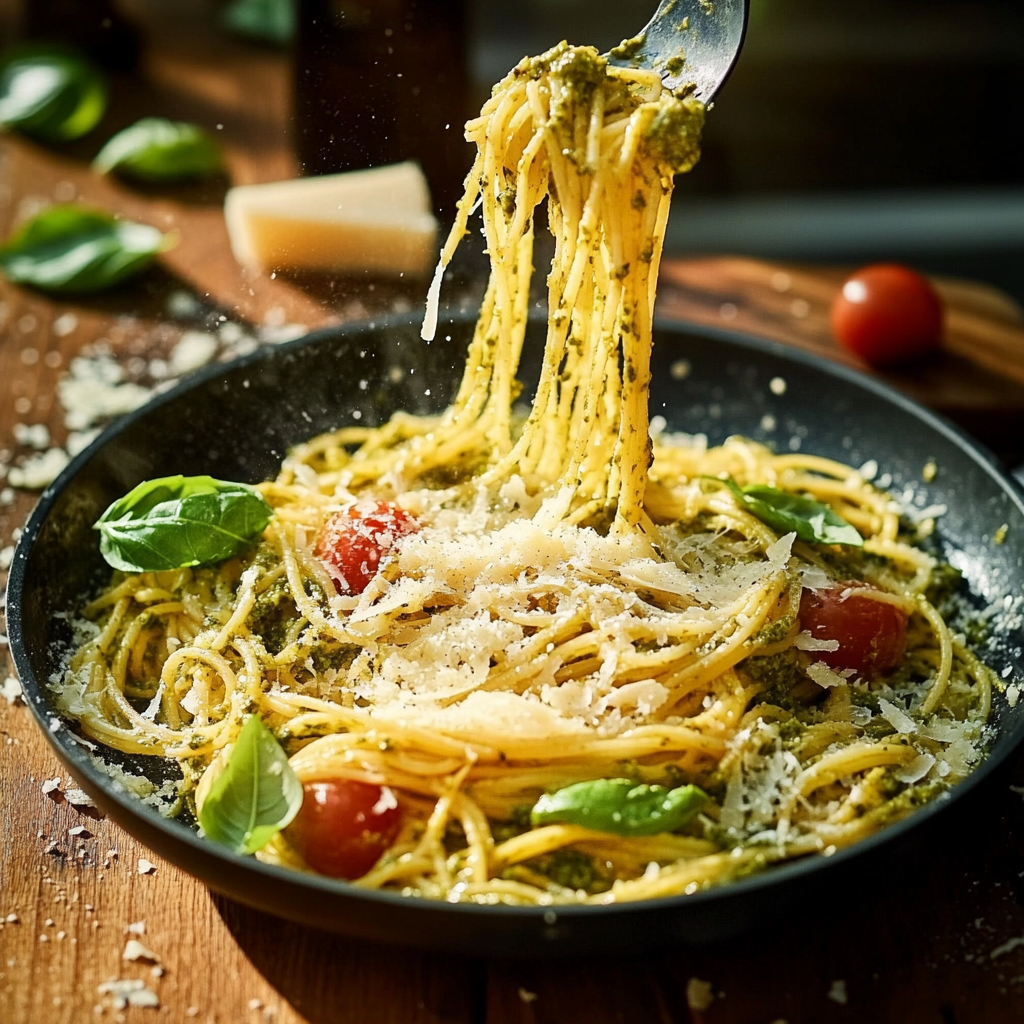
FAQs
What type of basil should I use for my pesto?
For making spaghetti with pesto and Parmesan, sweet basil is typically used due to its mild flavor profile complemented by hints of mint and peppery notes. This variety creates an aromatic base that enhances overall taste when blended into sauce form. Some people may opt for other herbs like arugula or kale; however, they will yield distinct flavors different from traditional basil-based recipes.
Can I use pre-made store-bought pesto?
Absolutely! However, enhance store-bought varieties by adding fresh ingredients like lemon juice, garlic cloves, or freshly grated cheese for an extra kick in flavor—this simple step elevates even commercial products significantly without requiring much effort on your part!
How do I store leftover spaghetti with pesto?
After enjoying your delicious meal, store any leftovers in an airtight container in the refrigerator for up to three days maximum—ensure they’re cooled completely before sealing! Reheat gently over low heat on stovetops while adding additional olive oil if necessary for moisture retention; avoid microwave usage unless absolutely needed since it could lead towards rubbery textures.
Is there a vegan alternative to Parmesan cheese in my recipe?
Yes! For those seeking dairy-free options: nutritional yeast serves well as a substitute due to its cheesy flavor profile—it provides umami richness that complements dishes beautifully! Alternatively try cashew-based cheeses marketed specifically towards vegans within health food stores—these products mimic traditional cheeses nicely!
Can I freeze leftover spaghetti with pesto?
Freezing cooked pasta mixed with sauces may result in textural changes once thawed; therefore it’s generally advised against doing so directly instead freeze individual components separately: place sealed bags filled solely containing homemade pestos inside freezer compartments while keeping cooked pastas stored elsewhere until needed later down line!
How can I make my homemade pesto more flavorful?
By incorporating roasted garlic cloves alongside other ingredients such as parmesan cheese & nuts—a quick roast brings out natural sweetness found within garlic cloves enhancing overall dimensions present within finished product! Additionally consider experimenting by adding spices like crushed red pepper flakes which introduce subtle heat balancing perfectly against creamy richness delivered through oil & nuts present throughout this sensational dish!
Conclusion
In conclusion, mastering spaghetti with pesto and Parmesan requires understanding common mistakes to avoid during preparation while embracing helpful tips tailored towards enhancing flavors within this classic dish. Ensure proper cooking techniques are observed—such as timing when combining hot pasta directly after draining—and always prioritize quality ingredients ranging from fresh basil leaves all way through aged Parmigiano-Reggiano cheese sourced locally whenever possible! By following these outlined suggestions regarding nutrition choices alongside relevant FAQs shared earlier here today: expect unforgettable dining experiences every single time you prepare this delectable Italian specialty surrounded by family members friends alike! Enjoy experimenting today!
